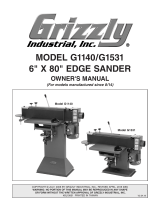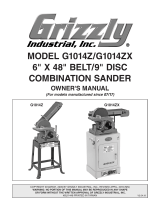Page is loading ...

Eects of Pressure on the
Performance of Abrasive Belts | 1
Eects of Pressure on
the Performance of
Abrasive Belts
JD Haas, 3M Abrasives Division

Eects of Pressure on the
Performance of Abrasive Belts | 1
I
n recent years, the abrasive
industry has seen signicant
advancement in technology.
The incorporation of new tools
and innovations like Precision
Shaped Grain (3M) into abrasive
operations can increase eciency
and productivity. All abrasives are
engineered to perform with an
optimal breakdown point. That is,
the abrasive grit must break down to
reveal new cutting edges. However,
this point is often not reached, and
maximum output potential is reduced
because the abrasive is applied with
unsuitable pressure. If you have
a product that should be lasting
twice as long, but you’re only seeing
average output, then other mitigating
factors need to be addressed. One
such facet of abrasive grinding that is
often overlooked or misunderstood
is pressure. The two key components
to ensure optimal abrasive
performance include selecting the
correct product and running that
product at the appropriate pressure.
The key is matching the product to
the application’s pressure. Under
appropriate pressure conditions, you
can ensure an optimal breakdown rate
of your abrasive belts, maximizing
both cutting speed and product life.
Figure 1 | Close-up of the microtechnology of Precisely Shaped Grain (PSG).
Figure 2 | Comparative chart of Conventional
Crushed Ceramic Grains plowing vs. Precision
Shaped Grain cutting metal substrate.
3M oers a complete
portfolio of low, medium
and high pressure abrasives.
These products are carefully
designed for optimal break-
down under appropriate
application pressure.
3M PRECISION SHAPED GRAIN
In the last several years, 3M scientists
have ne-tuned innovative precision
grain technology. First introduced to
the industry in 2009, 3M Precision
Shaped Grain (PSG) is an abrasive
grain that performs at a higher
capacity than traditional crushed
grain. Crushed grain is manufactured
by conventional crushing and
screening techniques producing a
varied distribution of particles in both
size and sharpness. When the crushed
grain is coated onto an abrasive
backing, the result is a distribution
of irregular shapes and heights of
grain. Conversely, using PSG yields
a desirable and virtually monolithic
distribution of abrasive grains that are
readily available to perform abrasive
manipulations on work surfaces as
shown in Figure 1.
The mechanism for metal grinding
and chip formation is one of the
key factors in fundamentally
understanding why PSG products
perform at such a high level.
Conventional crushed ceramic
grains—because of variations
in grain distribution and mineral
sharpness—have cutting tips that act
as “plows” as they cut, which cause
high frictional force and heat build-
up in the substrate. The homogenous
shape and sharpness of the PSG
slices through metal, resulting in
more ecient chip formation and
metal removal while greatly reducing
heat-related part damage. Figure 2
illustrates the plowing of the crushed
grain versus the cutting of precision
shaped grain. As with all abrasives,
PSG-containing belts perform at
peak capacity when operated under
suitable pressure.

Eects of Pressure on the
Performance of Abrasive Belts | 2
UNDERSTANDING BELT AND
APPLICATION PRESSURE
Combining the right belt with the
right application pressure is essential
to reaching the optimal breakdown
point of an abrasive. The wrong
variable in either of these elds can
lead to suboptimal results evident
on the workpiece and the used belt.
Using either excessive pressure or
insucient pressure during grinding
can have eects on the performance
of an abrasive and the materials
it’s grinding.
Understanding how low and high
pressure abrasives operate can be
visualized like a bed of nails. If a
person were to lay their hand across
compact, closely spaced nails, it
would require lots of force and
pushing against the nails to puncture
the skin. Imagine now a single nail
stuck through a board: signicantly
less force would be required for
the nail to penetrate if someone
pushed their palm against it. Similar
to a bed of nails, high pressure belt
surfaces have many grains tightly
packed together and can withstand
higher force during application.
Low pressure belts are designed
with grains placed further apart so
less force is needed for them to cut
through the substrate. This is the
concept of application pressure: the
force applied divided by the geometry
of the workpiece. High application
pressure requires closely spaced
minerals, and low application pressure
requires minerals that are further
spaced out. Selecting the appropriate
belt pressure—high, medium or low—
for the desired surface modication
is the rst component for yielding
optimal abrasive performance.
In some cases too much pressure
can be applied to an abrasive. This is
more likely to occur in an automated
system, although it can occur in an
o-hand application as well. Typically,
it is more likely to occur in automated
or robotic grinding systems where
application pressure is high to achieve
high removal rates. A telltale sign
to look for in this instance would be
shelling. Figure 3 depicts an example
of a belt where too much pressure
was applied and shelling occurred.
The shelling can be noticed rst at
the splice. If shelling occurs before
optimal abrasive life is reached, it
is likely that application pressure is
too high. In these cases, selecting
a product with a higher application
pressure range would be appropriate.
An abrasive like 3M™ Cubitron™ II
984F Abrasive Belt performs well
under these very high pressure
conditions and diminishes the
likelihood of shelling.
Figure 3 | Image depicts an example of
shelling, which can result from applying too
much pressure.
Figure 4 | Image depicts an example of
glazing which can result from not applying
enough pressure.
In most cases, the application
pressure is too low for the product
selected. Applying too low of
pressure results in dierent visual
cues. The telltale sign of insucient
pressure is when glazing, or capping,
occurs on the abrasive. Figure 4
shows an example of an abrasive
belt where glazing occurred. In the
side-by-side comparison, it is evident
the belt on the right appears capped
with metal from the workpiece. This
happens because pressure that is
too low causes the abrasive to rub,
rather than cut, the substrate. The
friction incurred from the rubbing
increases the heat between the belt
and the workpiece. This can result in
pieces of the workpiece being welded
to the abrasive. Glazing, or capping,
can occur after one application if
the pressure is insucient, and will
eectively curtail the lifespan of the
abrasive. The appearance of shelling or
glazing on used abrasive belts are visual
cues that the belt selection, application
pressure, or both should be altered.

Eects of Pressure on the
Performance of Abrasive Belts | 3
SUMMARY
Pressure, as it concerns the abrasive
grain of the belt and the application
force, aects the optimal breakdown
of an abrasive. Identifying optimal
breakdown helps extract the full
potential of the abrasive and lowers
the costs of operations. Like all
abrasives, the technology of 3M’s
Precision Shaped Grain (PSG) belts
will perform at a higher capacity
under suitable application pressure
conditions. If unsure of application
pressure, starting with a medium
pressure belt and observing belt
feedback for cues of too much or
too little pressure, and then adjusting
accordingly, can achieve the utmost
value from the abrasive.
The innovative technology behind
3M PSG was developed in 3M
laboratories, where dedicated
scientists use their expertise to
develop abrasive solutions to
improve customer outcomes.
For more information on belts and
other PSG-containing products, visit
3M.com/metalworking.
RECOMMENDED TESTING
PROCEDURES
Appropriate pressure can vary
depending on the material of the
workpiece and the desired stock
removal. To determine whether both
the pressure of the belt and the
application pressure are suitable for
peak abrasive performance, running
diagnostic tests and evaluating the
belt feedback is recommended. If
there is uncertainty surrounding
which belt pressure to select,
3M recommends starting with a
medium grain belt like the new 3M™
Cubitron™ II Abrasive Belt 784F. This
versatile belt is designed for medium
pressure grinding and dimensioning
on a variety of metals.
By completing a trial grinding of the
workpiece, an operator can ensure
the optimal force is being applied.
Pressure adjustments can then be
made where necessary. Inspect
the belt after the test for signs of
shelling or glazing. If shelling is
apparent, either lower the pressure
that is being applied or move up to
a higher pressure belt, such as the
3M™ Cubitron™ II Abrasive Belt
984F. When performing o-hand
applications, insucient pressure is
common. If there is capping of the
mineral, rising heat on the workpiece,
or you can visually identify glazing,
then try switching to a lower pressure
belt, such as the 3M™ Cubitron™ II
Abrasive Belt 384F.
Figure 5 | Reference chart for testing and selecting recommended 3M belt based on pressure.
Figure 6 | Image illustrating the range
of materials and congurations of
contact wheels.
Contact Wheel
The material and conguration of
a contact wheel is an important
factor when determining optimal
grinding pressure. Contact wheels
are available in many dierent
variations, each designed to serve
a dierent purpose in abrasive
applications. Materials like steel or
hard rubber yield higher application
pressure than will softer wheels like
cloth and soft rubber. Additionally,
the conguration of the contact
wheel aects application pressure,
with serrated wheels causing
signicantly higher pressure than
smooth wheels. If the operating
contact wheel is cloth or soft
rubber, it is best suited for low
pressure, less aggressive processes
like rening and nishing the
workpiece, or where undercutting
is a concern. When testing for
appropriate pressure and abrasive
breakdown, it is critical to take the
material of the contact wheel and
its conguration into consideration.
3M Abrasive Systems Division
3M Center, Building 21-1W-10
St. Paul, MN 55144 USA
Phone 1-866-279-1235
Web 3M.com/metalworking
3M and Cubitron are trademarks of 3M.
Used under license by 3M subsidiaries and
aliates. 61-5002-8429-6
Please recycle. Printed in USA © 3M 2016
All rights reserved.
/


